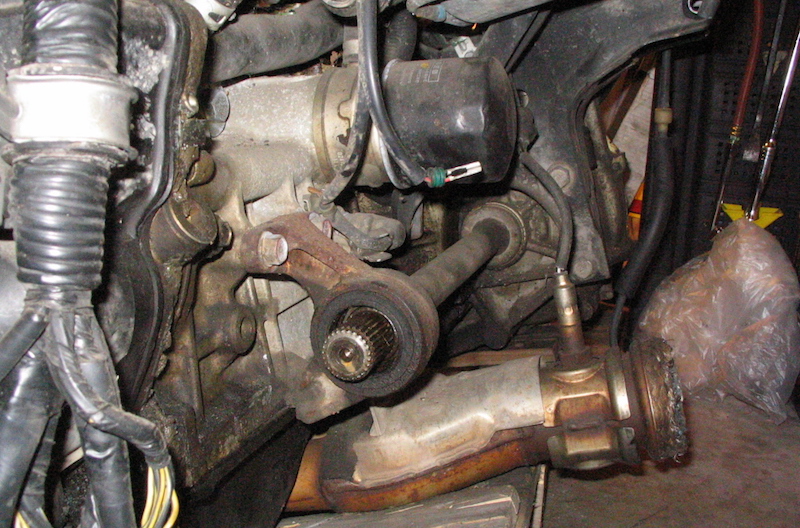No doubt you know that an illuminated Check Engine Light (CEL) means that there's at least one sensor for a system in your engine or drivetrain that has registered a reading that's outside of normal specs. When that happens, the information is stored in the powertrain control module (PCM) as a trouble code, illuminating the CEL. From there, it's a simple matter for a technician (or you) to connect a code reader device to the multi-pin diagnostic port under the dash, usually on the driver's side. With the code reader, you can quickly access any trouble codes stored in the PCM and get a jump on diagnosing the problem.
The industry adopted OBD-II diagnostic protocols across the board in the mid-90s, with a standardized set of codes for all makes and models. It gives a huge head start in troubleshooting any problem, but it can get tricky when a single problem results in a string of trouble codes. In those events, use some deduction and logical testing to narrow down the root cause instead of just replacing parts.
Also, before proceeding with any troubleshooting, it's a good idea to find out if there are any recalls or Technical Service Bulletins (TSBs) that address your specific problem. You should also clear the trouble codes in the PCM and test-drive the vehicle to see if they return. Some problems on some year/make/models may require several failure cycles before a trouble code is stored again.

P0206: What It Means
Your engine's fuel injectors are activated by a solenoid, which in turn is activated by a transistor called a "driver." Each cylinder's injector is supplied with power from the battery, at one of two terminals. When it's time to squirt fuel into the cylinder, the PCM grounds the other terminal and completes a circuit, which activates the driver and solenoid to open the injector. This code could be due to a bad injector, an open or short connection, an intermittent open or short, a bad ground or even a bad PCM (though rare).
Note: on V6 and V8 engines, look for the cylinder bank that is offset slightly forward from the other, and that bank will be the odd-numbered cylinders.
Drivers commonly use either the "saturated switch" or "peak-and-hold" designs. With a saturated switch, the PCM supplies maximum voltage from the time the injector's needle valve opens until it shuts again. A peak-and-hold design supplies a pulse of maximum voltage, then drops the voltage to just enough to keep the valve open.
Code P0206 indicates an injector misfire on cylinder 6, with the PCM commanding the injector to open but not recognizing a change in electrical current that would indicate the injector fired. This trouble code is similar to P0201, P0202, P0203, P0204, P0205 and P0207, and P0208, and may be accompanied by one or more of those codes.
Symptoms
These symptoms can vary by year/make/model:
- Rough running
- Stalling
- Misfire
- Poor fuel economy
- Limp-in mode
- Rich-running or lean-running
- Hard-start condition
What Happens If I Ignore It?
If your vehicle is in limp-in mode, you may have a top speed that's limited to about 40 mph or less. Chances are that if you have a P0206 OBD-II trouble code, your vehicle will be running poorly enough that it won't be very drivable. In any event, ignoring a P0206 code for long can lead to further engine damage.
Possible Fixes
- Check the wiring to the injector for loose connection, damage or corrosion. Perform a wiggle test.
- Using a multimeter, check the resistance of the injector. If this doesn't fall within spec, it may be the injector itself.
- Once you've determined which cylinder is misfiring, you can easily check by using a test light (aka "noid light"). Disconnect the injector and plug the noid light into the connector. If the noid light flashes, as you crank the engine, the control circuit for that injector is working properly. If it doesn't flash, or stays on the entire time, there's a problem.
- To test the circuit for power from the PCM, use a circuit test light and attach one lead to ground. Attach the other to the B+ pin on the connector. The light should illuminate. If the test light isn't lighting up or lights weakly or intermittently, use your multimeter for a voltage check as well.
Testing a circuit has the potential to get confusing. Remember that your best bet is to keep a cool head, use some critical thinking/deduction and keep it simple. Isolate the circuit into segments to rule out problems, starting with whatever is easiest and quickest for you to check. In this case, that means starting with a visual inspection and then moving on to the injector itself. If you need to replace a fuel injector, we've got you covered there, too.








